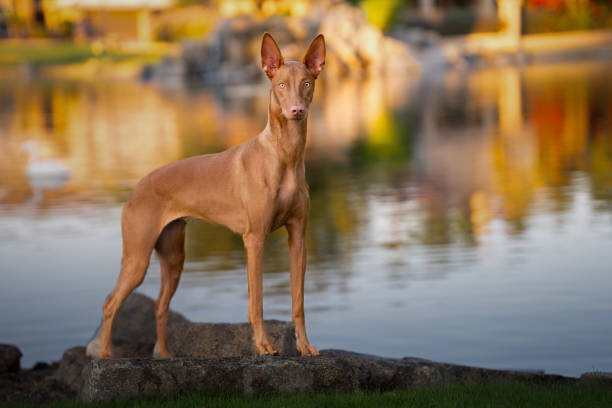Pharaoh Hound

Breed History:
The Pharaoh Hound is one of the oldest known domesticated dog breeds, with origins tracing back over 5,000 years to ancient Egypt. Dogs resembling Pharaoh Hounds appear in Egyptian art, hieroglyphs, and sculptures, often depicted hunting alongside pharaohs and nobility. Despite its Egyptian roots, the modern Pharaoh Hound was preserved and developed in Malta, where it is known as the Kelb tal-Fenek, meaning “Rabbit Dog,” due to its role in hunting rabbits across rocky terrain.
The breed was introduced to the rest of Europe in the 20th century and gained recognition for its elegance, intelligence, and remarkable speed. It is now Malta’s national dog and symbol of cultural heritage.
|
Gender |
Height |
Weight |
|
Male |
56–63 cm |
20–25 kg |
|
Female |
53–61 cm |
18–23 kg |
Size – Medium
Life Expectancy: 11–14 years

Breed Appearance:
The Pharaoh Hound is a striking and athletic breed with a sleek, graceful build and noble bearing. It has a short, glossy coat in rich tan or chestnut hues, often with white markings on the chest, toes, and tail tip. One of its unique traits is the ability to “blush,” where the nose and ears turn pink when the dog is excited or happy.
Its head is long and chiselled with large, upright ears that are expressive and alert. The eyes are amber-colored and almond-shaped, giving an intelligent and gentle expression. Its body is lean, muscular, and built for speed and agility.
Breed Type – Family/Hound:
The Pharaoh Hound is affectionate, playful, and gentle with its family. It is known for forming close bonds with its owners and thrives in a household where it receives consistent attention and companionship. Though sociable and outgoing with people it knows, it may be reserved with strangers.
Originally bred for hunting, it retains strong prey instincts and high alertness, making it a vigilant watchdog without being aggressive. It is best suited for experienced owners who can handle its energy, sensitivity, and independent streak.

Training:
This breed is intelligent and quick to learn, but also has a strong independent nature. Positive reinforcement, patience, and consistency are key to successful training. Harsh corrections are counterproductive, as the Pharaoh Hound is sensitive and easily discouraged.
Early socialisation is crucial to help the dog adapt to new environments, people, and other animals. Recall training can be difficult due to its prey drive, so off-leash activities should be in securely fenced areas.
Health & Care:
Pharaoh Hounds are generally healthy and robust, with few breed-specific genetic issues. However, they can be prone to:
-
Allergies (environmental or food-related)
-
Hip dysplasia (rare but possible)
-
Sensitivity to anaesthesia (common in sighthounds)
Their short coat and low body fat make them vulnerable to cold, so they may require a coat in colder weather. Routine vet check-ups, a balanced diet, and regular dental care contribute to long-term health.

Living Conditions:
The Pharaoh Hound adapts well to both suburban and rural homes but is not ideal for apartment life unless it receives sufficient exercise. It requires a securely fenced yard due to its high prey drive and chasing instincts.
It prefers to live indoors with its family and enjoys being part of daily activities. This breed does best in homes where it isn’t left alone for long periods, as it thrives on companionship and mental engagement.
Exercise:
An energetic and agile breed, the Pharaoh Hound needs at least an hour of daily exercise. Activities such as long walks, runs, fetch, lure coursing, and scent work provide both physical and mental stimulation.
Without enough activity, it may become bored or develop undesirable behaviours. Due to its prey drive, outdoor exercise should always be supervised or in enclosed areas.
Grooming:
This breed’s grooming needs are minimal. The Pharaoh Hound has a short, fine coat that requires:
-
Weekly brushing to remove loose hair
-
Occasional bathing to keep the coat clean
-
Regular ear checks and cleaning to avoid infections
-
Routine nail trimming and dental hygiene
It is a naturally clean dog with little odour and minimal shedding.

Advantages:
-
Elegant, athletic appearance with ancient heritage
-
Intelligent, loyal, and affectionate with its family
-
Minimal grooming needs and low doggy odour
-
Playful, sociable, and good with respectful children
-
Generally healthy with few genetic problems
-
Excellent watchdog without being aggressive
Disadvantages:
-
Strong prey drive; not suitable for homes with small pets
-
Needs daily exercise and mental stimulation to prevent boredom
-
Can be independent and occasionally stubborn
-
Not ideal for first-time dog owners without proper research
-
Sensitive to cold due to low body fat and short coat
-
May be aloof with strangers or overly shy if not socialised early

